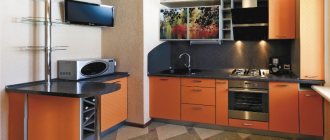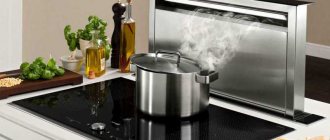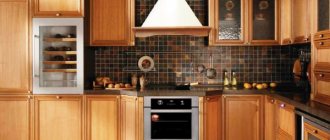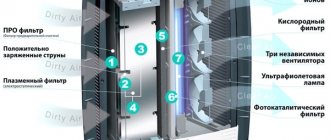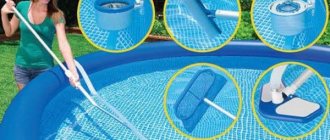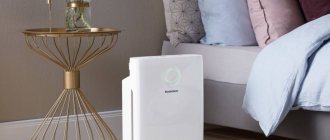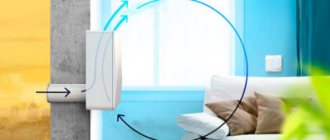Not only total ventilation will help get rid of annoying aromas spreading throughout the house/apartment during the process of preparing dishes in the kitchen.
A charcoal hood will be an excellent helper in such a situation - it will effectively purify the air, saturated with the aromas of fried chicken, garlic dressing and seasoned with the sweetish aroma of baking chocolate biscuit. What else the equipment can do and how it works – we’ll talk about this in our article.
We will also discuss the design of this type of kitchen hood, dwell on the intricacies of choice, consider the installation features and provide useful recommendations for caring for the equipment.
Principle of operation
If for certain reasons you cannot install an air duct in your room, you should not look for ways to install it in other areas of the kitchen. It is enough to purchase a hood with recirculation properties, as it will perfectly cope with its main task even in a small isolated space .
The peculiarities of this type of hood are that it processes the air directly inside the exhaust duct.
The recirculation mode in the hood allows the air to be quickly cleaned and returned to the room. Contaminated air enters the hood and passes through one or more filters.
This hood quickly clears the air of contaminants and has sufficient power to clean rooms where a lot of cooking is done frequently.
The quality of air recirculation in the hood largely depends on how many filters are installed in it. Modern hoods use two types of filters. The first - fat - is attached to the outside of the hood: as a rule, it is made of metal and serves to retain fat deposits on the surface. It is enough to clean such filters periodically using detergents.
The second type of filter - carbon - serves directly to clean the air penetrating deep into the air . Filters of this type cannot be cleaned, so they will have to be renewed approximately every 3 months of operation of the hood. On average, one high-quality filter of this type will cost about 200 rubles.
Attention! Despite their high operating efficiency, hoods with recirculation mode also have disadvantages. The main one is the impossibility of completely getting rid of unpleasant odors in the room.
Difficulties during operation may also arise with the replacement of filter systems. It will not be difficult to install them yourself, but it is not always possible to predict the need for replacement in time.
To ensure that customers do not forget about changing filters, manufacturers equip modern models of hoods with special sensors that notify them when they are dirty .
As you may have noticed, the main advantages of using a recirculating hood are that you do not need a ventilation shaft . In addition, when equipping an island kitchen, it can be difficult to determine the optimal location of hoods with air venting.
To ensure that this equipment serves you for as long as possible, do not forget about timely cleaning and careful care . Since there will be humidity in the room when operating hoods with recirculation, there is a possibility of mold forming in the room. Regular ventilation of the kitchen will solve this problem.
A powerful recirculating hood without an air vent will cost very little, but will cope with the task of cleaning the air in your kitchen. Therefore, experts consider this technology option to be one of the most successful among all economy class hoods.
Design and features of coal exhaust
You can find conflicting opinions about coal hoods - from total respect to complete contempt. Opponents believe that no filter can cope with annoying kitchen aromas. And maintenance of a device with carbon filters will cost a pretty penny. A closer acquaintance with this technique will help to defeat these beliefs.
Is a carbon filter necessary?
A common feature in the kitchen is a powerful hood with an air duct. It is she who is able to quickly remove exhaust air from the room, preventing it from spreading into adjacent rooms, provided that the power is correctly selected.
But the air does not have to be evacuated from the kitchen - it can be purified using devices with a fine filter.
Fine cleaning using a carbon filter allows you to remove all impurities from the exhaust air, which eliminates foreign odors
It is against a hood with carbon filters that many skeptics rebel, believing that it is in no way capable of coping with the task. And all arguments to the contrary are nothing more than advertising.
In fact, such a hood has repeatedly proven that it has the right to be used not only in private houses and apartments, but also in professional kitchens of restaurants, cafes and other premises where it is necessary to effectively purify exhaust air from impurities.
Not only does the device perfectly remove odors, but it is also easy to install and requires minimal maintenance. Moreover, all this, if desired, can be easily done independently - you don’t have to drill or break anything.
Few people like it when the aromas of fried potatoes and bacon spread not only on the 1st floor, but also rise to the 2nd thanks to the special layout of the room and the absence of interior doors
Another advantage is the wide price range. Hoods that rid the room of various aromas are designed both for users with modest demands and for fastidious and fairly wealthy owners.
In addition, a regular hood with an air duct can have the function of purifying air from impurities without removing it from the room - many models in the mid-price range have an additional operating mode. This is recirculation - by pressing one button, it switches to air purification mode without removing it from the room.
Also, without such a device it would be difficult to install in rooms where it is problematic to install a conventional hood that evacuates exhaust air into the ventilation shaft. Especially when there is simply no such mine, and the smells need to be gotten rid of somehow.
The shape and location of installation of a hood without exhaust air exhaust depends on the manufacturer’s imagination and allows even the most daring design solutions to be implemented.
Types and design of hoods without outlet
The hood that purifies exhaust air differs from the usual one by the presence of an additional fine filter. And in some cases, the absence of an air duct. These devices are produced by the same companies that produce evacuation hood models. Moreover, one hood can have 2 modes at once - air extraction and air purification.
Fine filters are usually made of heat-resistant material that can withstand high temperatures and contain an absorbent component - carbon
Such a device consists of the following parts:
- housing that houses the main operating components;
- control panels - it can be push-button or touch-sensitive;
- the motor responsible for the operation of the unit;
- coarse and fine filters - there can be 2 or more of them;
- plugs for connecting to the network;
- lighting lamps;
- It is possible to have an air duct if the model has an evacuation mode of operation.
Depending on the model, such a hood may have a different appearance, a different number of operating modes, and will differ in the number of speeds, power and quality of performance of its main functions.
Also, the cost of the unit can be from a couple of thousand to 20-40 thousand rubles or more.
A coarse filter, also known as a grease filter, must be installed before the coal filter in an appliance that purifies the air in the kitchen from impurities and odors.
Air purification devices have one thing in common - the presence of an additional carbon filter and the ability to work without evacuating exhaust air. And the case material, its design, color and other features may be similar to models of exhaust devices from the same manufacturers.
Image gallery
Photo from
Intricate shape of coal hood
Glossy white hood
Island hood with recirculation function
Touch control of the hood
Operating principle of the equipment
Equipment with fine filters operates in recirculation mode. It does not require the installation of special channels to remove exhaust air containing impurities and tiny particles of fat and soot.
The essence of how such a hood works is that it draws polluted air inside its body. Along the way there is a grease filter, on which larger particles of fat, soot and other impurities found in the exhaust air remain.
The grease filter needs frequent cleaning if the hood is used regularly. It is important to wash it when it gets dirty
Then comes the turn of the fine filter, in which the air is further purified from smaller particles. Some models have another carbon filter, which more delicately cleans the air that has passed through the grease and first carbon filters.
After cleaning, the air is returned back to the room. And a new portion of the waste gets back inside the equipment.
It turns out that the main role in the carbon device is played by filters. They differ in appearance - there are cassette systems and coal pillows. Most often, each model of hood uses its own carbon filter, but there are also universal ones that are suitable for many appliances.
The appearance, shape, weight and size of carbon filters differ greatly from each other and depend on the hood model
The carbon filter is made from various materials. This can be a disposable or reusable accessory. The main working component in it is the absorbent material – activated carbon. It happens:
- stone;
- peat;
- coconut;
- impregnated.
And the shape of the filter depends on the model and design of the hood. It can be round, rectangular, concave, flat, or in the form of a cassette of a couple of centimeters.
The service life of carbon filters depends on the frequency of switching on the hood and the duration of its operation. The more often this happens, the more often the filter will have to be changed. After all, when coal is filled with fat, soot and other impurities, the exhaust air practically does not pass through such a dirty filter. Accordingly, further cleaning is impossible without replacing or restoring the carbon accessory.
If desired, you can buy a universal carbon filter. It is given the desired shape and size using the most ordinary scissors. The main thing is that its installation does not affect the quality of the hood.
To slightly extend the performance of the carbon filter installed in the hood, manufacturers recommend turning on the equipment simultaneously with the start of the cooking process.
And turn it off only 5 minutes after turning off the stove/oven.
Working for 3-5 minutes after the end of the cooking process, the hood allows excess moisture to evaporate, which will prevent rapid wear of the carbon absorbent
More about filters
To increase the productivity of the hood, it is important to decide on filter systems. Depending on the material and design of the filters, several types of hoods can be distinguished.
Here are the main ones:
- single-stage and two-stage;
- 1st and 2nd level cleaning systems.
Single-stage recirculating hoods are equipped with only one filter : this is either a disposable filter (for example, acrylic), which must be replaced, or a reusable one, in which it is enough to change only the internal cassette.
A cleaning system that includes two filters is considered more effective. Standard recirculating hoods are two-stage : polluted air is not only cleaned of grease and fumes, but also partially gets rid of unpleasant odors.
First-level filters maintain their functionality through periodic cleaning. They can be acrylic or made of metal. Second-level filters - carbon - are not cleaned, but they provide maximum air purification.
When choosing a kitchen hood model, pay attention to a detailed study of its filtration system . A coal hood will be the most effective, but there is not always a need to use such equipment in the kitchen. Therefore, it is better to consult with specialists, notifying them about the frequency of cooking and the size of your kitchen.
Pros and cons of a recirculating hood with a carbon filter
These models are among the most popular options. Their advantages include:
- The ability to install a hood in any kitchen, since it does not require a connection to the air duct;
- The ability to completely and deeply purify the air from smoke and odors;
- There is no need for new portions of air to come in: bleed options completely “remove” the drawn-in air without giving it back;
- Space saving, the ability to be built into furniture, for example, attached to the bottom of a wall cabinet;
- Preservation of heat and, therefore, saving money on heating: the air does not escape outside and is not replaced by cold air, which requires heating;
- Easy to install: This also comes with no need to connect to the ductwork;
- Low cost.
Requires filter replacement every 3-5 months
Disadvantages include noisier operation and the need to change filters. The latter must be done every 3-5 months, however, each company has its own recommendations in this regard: for example, Bosch, Falmec and others suggest replacing only once a year.
Attention! Compared to exhaust models, the efficiency of recirculation models is only 70-80%: this is due to the continuous circulation of air in a confined space.
Installation Features
Installing such hoods is quite simple. To begin, hang the equipment above your cooktop or stove; most range hoods come already equipped with brackets. Flat models can be mounted in wall cabinets: observe the features of purified air outlet.
When the hood is secured, you can begin to supply electricity . If there is no outlet near the installation site to which you can connect the hood, lay a cable of the required length and connect the wires directly from the junction box.
Remember! It is important to take into account fire safety rules when attaching recirculation exhaust devices. The distance between the cooking surface and the grease filter must be sufficient to ensure that it does not catch fire due to contamination during the cooking process.
If you choose this type of hood to equip your kitchen island area, you will have to mount the equipment not to the wall, but to the ceiling. Accordingly, the electrical wiring will be connected to the hood from the ceiling area, so think about how to disguise it using fire-resistant finishing materials.
Features of caring for coal hood
Coal exhaust air purification devices require preventive inspections and maintenance. When it gets dirty, you need to remove the grease filter and clean it. To do this, use the same detergent as for washing dishes. It is important that when servicing the hood, be sure to turn it off from the electrical network.
Also, if during a routine inspection it is discovered that one of the light bulbs has burned out, it is necessary to purchase a similar model of the same power. It is also necessary to install it only after turning off the device from the network.
Air purification equipment has its own characteristics, which consist in periodically changing carbon filters. The frequency of these manipulations depends on the model of the device, frequency of use and manufacturer’s recommendations. At the same time as servicing the grease filter, the carbon filter should also be inspected.
An example of replacing a filter in one of the hood models is to remove the used carbon filter, located immediately behind the grease filter, and install a new one, securely fix it and attach the grease filter back. The manufacturer gives all this step by step. The rules for installing filters differ in different models of hoods. It is important to read the instructions and follow the manufacturer's recommendations
The carbon filter is located in the hood behind the coarse filter.
Can:
- purchase a spare filter from a service center;
- use a universal filter, giving it the required dimensions with scissors;
- clean the old one if it is a restored model;
- make your own carbon filter;
- replace the filler in the cassette filter model.
It all depends on the manufacturer’s recommendations, cost and availability of replacement carbon filters. So, if there are no problems with this, then it is easier and more convenient to purchase a ready-made accessory. Otherwise, the problem can be solved on your own.
To make a replacement filter, you will need sheet synthetic polyester, scissors and activated carbon in granules or tablets.
You need to cut blanks from the fiber using a used filter as a pattern.
Then, between 2 layers of synthetic padding, you need to place granular absorbent filler and carefully fix everything in the cassette.
In some filter models, the protective fabric layer can be carefully removed and washed - after these procedures it does not lose its properties and can be reused.
In a cassette filter, it is enough to replace the filler and, after drying the washed fabric material, glue it in its original place
You should read the instructions supplied by the manufacturer about the capabilities of your filter model. For example, there are wonderful carbon filters that can last 3 years. These are refurbishable accessories from Elica called Long Life. When they become dirty, they are washed, dried and put back in place.
The service life of different manufacturers and models of accessories may vary significantly.
It also directly depends on the intensity of use of the carbon hood - the less often it is turned on, the longer the filter will last:
- Elica, in addition to Long Life filters, has an average lifespan of 2 months;
- for Elikor, Falmec, Jetair it is 3-4 months;
- for Fabriano and Gaggenau - 6 months on average;
- and filters from Krona and Bosch have a service life of 12 months.
As for the cost, it ranges from 250 to 3000 rubles per accessory. Therefore, it is important to take care of a spare carbon filter in advance so that it is at hand at the right time.
Image gallery
Photo from
Remove the grease filter
The grease filter needs to be washed
Remove the carbon filter
Remove the new filter from the packaging
How to make the right choice
A few simple steps will help you choose a recirculating hood, which during operation will delight you not only with its practical properties, but also with its appearance:
- Assess your financial capabilities. If you can’t afford expensive models, think about what features you can give up . For example, instead of stainless steel options, you can choose models with a less modern design. Or stop at one filtration level.
- If you are going to cook a lot often, choose a hood with a charcoal filter . An aluminum filter is suitable for those who rarely cook - and mainly by boiling rather than frying in oil.
- Evaluate what type of hood would be most appropriate in your kitchen. The color and type of material will affect the harmony of the interior design. Recirculating hoods can be not only flat, but also volumetric, domed, inclined - such models will require more space.
- Consider the optimal speed of air inflow and outflow . The speed of circulation will determine the frequency of air renewal in your kitchen. The higher the power of the hood, the better, although the reliability of the filters will also affect the quality of its operation. The optimal performance indicator is the volume of the room multiplied by 12 and 1.3.
- Make sure that the hood does not make noise, and if it makes sounds and vibrations during operation, it does not cause you discomfort . Powerful fans are always the noisiest. You can find out about these indicators in the technical data sheet of the equipment.
How to install the equipment correctly?
When installing a coal hood, all the rules apply as when installing equipment with an air duct. In addition, the location of the ventilation shaft will not matter here if the device does not have an evacuation mode.
Firstly, it is important to maintain the height from the stove - at least 65 cm to the hood. Secondly, you will need an outlet to connect the device to the network. Thirdly, depending on the design features of the selected model, it will have to be installed correctly.
This could be installation in a kitchen cabinet niche or installation of a free-standing appliance. The manufacturer's instructions will detail how to install it correctly.
It may be enough to drill holes with a hammer drill and install special hooks from the installation kit that comes with the hood. Then securely fix it according to the instructions.
If this is a model with air exhaust and carbon filters, then, in addition to installation, you will also need a connection to the home’s ventilation system.
Thus, the installation of a coal hood model will directly depend on its design and functional features. After the box has been correctly installed and secured, you will need to install a carbon filter, following the manufacturer’s recommendations.
When installing the filter, it is important to hear a click, which will indicate the exact placement of the accessory in its workplace or in a special frame
After installing fine filters, you need to install grease filters - these are coarse filters, which are the first to take the blow during operation.
When all installation work is completed, you can turn on the device to the electrical network and press the corresponding button on the control panel. This way you can check the operation of the hood, which will indicate that all installation work was carried out correctly.
Do you want to install a hood yourself without a ventilation outlet? In this case, follow this link and read detailed instructions for its installation.
Prices for models from different manufacturers
The cost of this type of hood will depend on the material, design, additional features, reliability of the filter systems, as well as the manufacturer’s brand. We invite you to familiarize yourself with the most budget options.
A Hansa flat recirculation hood will cost you approximately 3 thousand rubles. A Liberty Base hood with similar properties will cost about 4.7 thousand. The Pyramida technique is popular today: recirculating hoods from this manufacturer are valued at 5 thousand rubles or more.
You can purchase even better options for hoods from the manufacturer Ventolux - such models will cost from 8.5 thousand rubles. The minimum cost of a Gorenje hood with recirculation mode is about 7.5 thousand rubles.
More well-known models with high functionality and modern design will cost you much more. For example, an Electrolux inclined recirculating hood will cost approximately 40 thousand, and Bosch equipment will cost an average of 55 thousand rubles.
Tip: For maximum air purification efficiency in the kitchen, purchase a recirculating hood with air exhaust. Such models are the most expensive.
Rules for choosing a coal hood
In order for the equipment to efficiently perform its functions of cleaning the air from various odors, to serve for a long time and not to cause additional problems, you need to take the step of choosing a hood responsibly. The quality of life and microclimate in the serviced premises will depend on the chosen model and its features.
You should not buy the first hood you like - you need to carefully study its technical characteristics and compare them with the required parameters suitable for your kitchen
It is easy to get confused among the proposed options for coal hoods. Choosing the right model may not be so easy - they are all so different.
It is important to focus on the following characteristics:
- number of operating modes;
- required number of speeds;
- device power;
- noisiness;
- size;
- cost of a replacement carbon filter and availability;
- the cost of the hood itself.
When choosing, the main thing is to immediately decide how many operating modes are needed and how much money can be spent on the device. This can be only exhaust air purification or a cleaning mode and an evacuation mode. The number of speeds affects the noise and speed of exhaust air processing.
A correction factor of 1.3 when calculating the required exhaust power is needed to ensure that the purchased device does not constantly work at the limit of its capabilities. This will extend its service life
Then you have to choose the right power of the equipment. Here you will need the area of the room and the height of the ceilings. To correctly calculate the power, you need to multiply these 2 values together, then multiply by a correction factor of 1.3 and multiply by the number of air updates in the room per hour - for the kitchen this is 12. The resulting value will be the required power.
As for the noise level of the hood, for coal models, as well as for options with an air duct, you should adhere to a level of 40 dB. The range can be expanded to 50 dB if none of the family members suffer from increased irritability. It’s good if it’s a model with 3-5 speeds, then maximum noise will be observed only when operating at the highest speed.
If the model you like has a noise level of more than 50 dB, it is better to refuse to buy it - 1-2 hours of cooking in the kitchen with the hood on will result in headaches, irritability and bad mood
When choosing, the size of the air purification device in the kitchen plays an important role. Its width must be no less than the width of the slab. Ideally, the hood should be 10 cm wider than the stove. This will ensure optimal purification of the exhaust air.
The cost of replacement carbon filters when choosing a device is also important - especially if a new one costs about 2,500 rubles. Here it is worth thinking about the advisability of purchasing such a model.
You should also pay attention to the period of use of the fine filter recommended by the manufacturer. This could be 2-3 months, or 9-12 months. And in some cases, even 3 years when it comes to refurbishable Long Life accessories.
Moreover, not only the cost, but also the availability of the desired filter model in your region is important. After all, if you have to change it every 2 months, and wait 3-4 months for delivery to the service center, then you clearly need to pay attention to a different hood model.
When the selected equipment meets all the criteria that are individual for each user, you can safely purchase the model you like. The main thing is that its price is also suitable.
Only with a responsible approach to the selection of equipment can one expect that the service life will be long and there will be no problems with the uninterrupted operation of the hood without outlet


